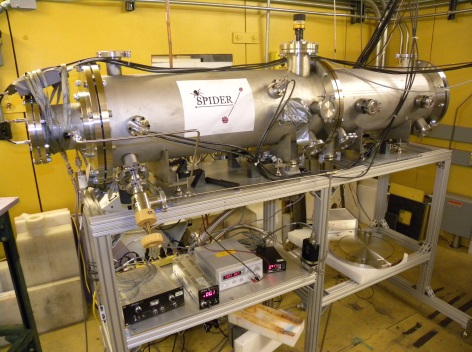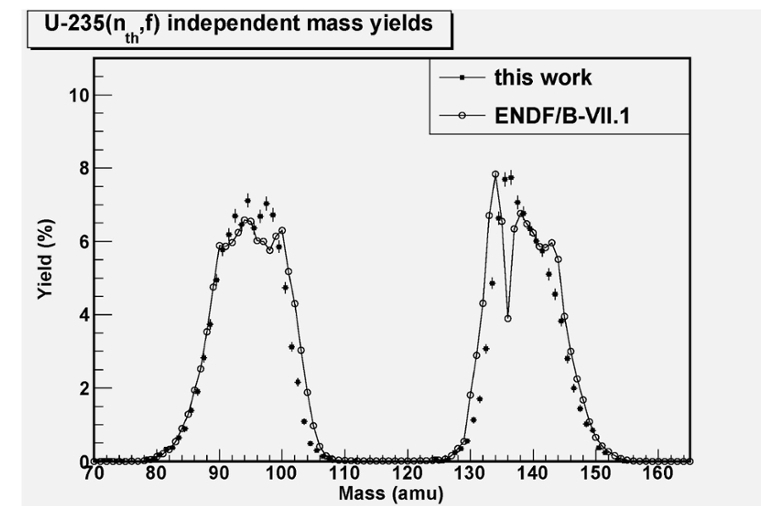Target 1 Flight Path 12
Target 1 Flight Path 12 (1FP12)
Target 1 Flight Path 12 utilizes cold neutrons from the 1L target. Liquid mercury shutter controls the neutron beam transmission from the target. The flight path views the partially coupled cold hydrogen moderator and a neutron guide has been installed to enhance the transport of cold neutrons to the sample position. It is a multi-use flight path that can accomodate a variety of experiments requiring a cold neutron spectrum. Two neutron beam choppers are available.
Scientific Applications
SPIDER Detector at LANSCE
Uranium undergoes fission with thermal neutrons. The fissioning isotope, 235U, splits into two asymmetric fragments. The distribution of the mass of these fragments–the mass yield–is an important test for different theoretical models of nuclear fission. In addition, it provides important data to nuclear weapons diagnostics, provides a way to determine the burn-up of nuclear fuel, and calculate the source-term for spent fuel waste stream analysis. Future measurements of 239Pu fission yields will provide a definitive answer regarding the energy dependence of 147Nd, which is of importance to the weapons program.
In recent years, a new instrument has been developed by members of LANSCE Weapons Physics (P-27) to measure fission-fragment yields as a function of the incoming neutron energy, the fragment mass and charge, and the total kinetic energy of the fragments. The instrument, named SPIDER (SPectrometer for Ion DEtermination in fission Research), aspires to achieve 2-5% accuracy for incoming neutrons between 0.01 eV and 20 MeV. Determination of the masses of the fragments utilizes the “2E-2V” method. In this method, the energy of each fragment is determined by its energy deposition in an ion-chamber, and its velocity by time-of-flight. This method provides a mass resolution of better than 1 amu and approximately 1 charge unit for the light fragment.
A prototype 2-arm spectrometer at 1FP12 is presented in Figure 1. Time pickoff detectors, which use an electrostatic field to focus electrons from a foil to a microchannel-plate detector, are evident on both sides of the fissile foil in the middle.

Figure 1. Prototype 2-arm spectrometer installed at FP12.
Figure 2 shows preliminary results from the measurement performed at the Lujan Center at LANSCE between October and November 2013. The graph shows the yield of fission fragments as a function of their mass. The characteristic asymmetric mass distribution in thermal fission of actinides is evident from the data; a light mass peak is observed around 95 amu and a heavy peak around 140 amu. Further work is needed before drawing conclusions about the agreement between the evaluated data (ENDDF/B-VII.1) and this experiment. An improved calibration of the instrument using radiation sources is planned at the end of the current LANSCE run cycle, and this might still change the experimental results slightly.

Figure 2. Preliminary results: The yield of fission fragments as a function of their mass.
Future plans
Future plans include the construction of 8-10 detector arms to enhance the acquisition rate and allow for the measurement of fast-neutron-induced yields.
The detector design, construction, and analysis was the result of a collaboration between Los Alamos, University of New Mexico, Colorado School of Mines, Slovak Academy of Sciences, Lawrence Livermore National Laboratory, and Lawrence Berkeley Laboratory. Los Alamos participants include Fredrik Tovesson, Krista Meierbachtol, and Dan Shields (P-27), Morgan White (Materials and Physical Data, XCP-5), Charles Arnold and Todd Bredeweg (Nuclear and Radiochemistry, C-NR), Justin Jorgenson (Applied Engineering Technology, AET-5), and Arnie Sierk (Nuclear & Particle Physics, Astrophysics and Cosmology, T-2).
Instrument construction and research, which supports the Laboratory’s Nuclear Deterrence mission and Nuclear and Particle Futures pillar, was funded by the LDRD program.

